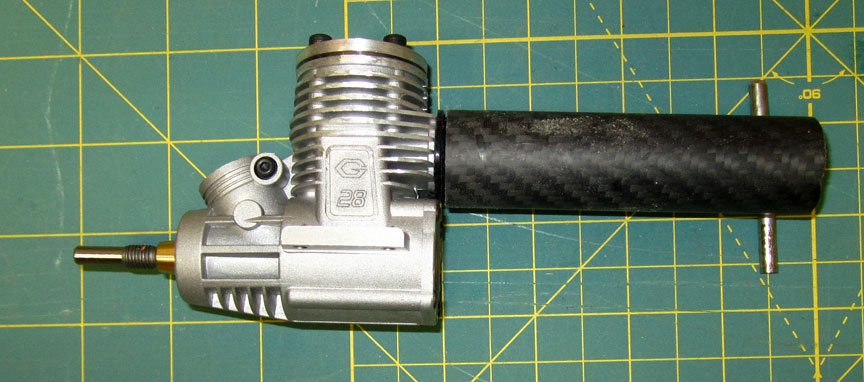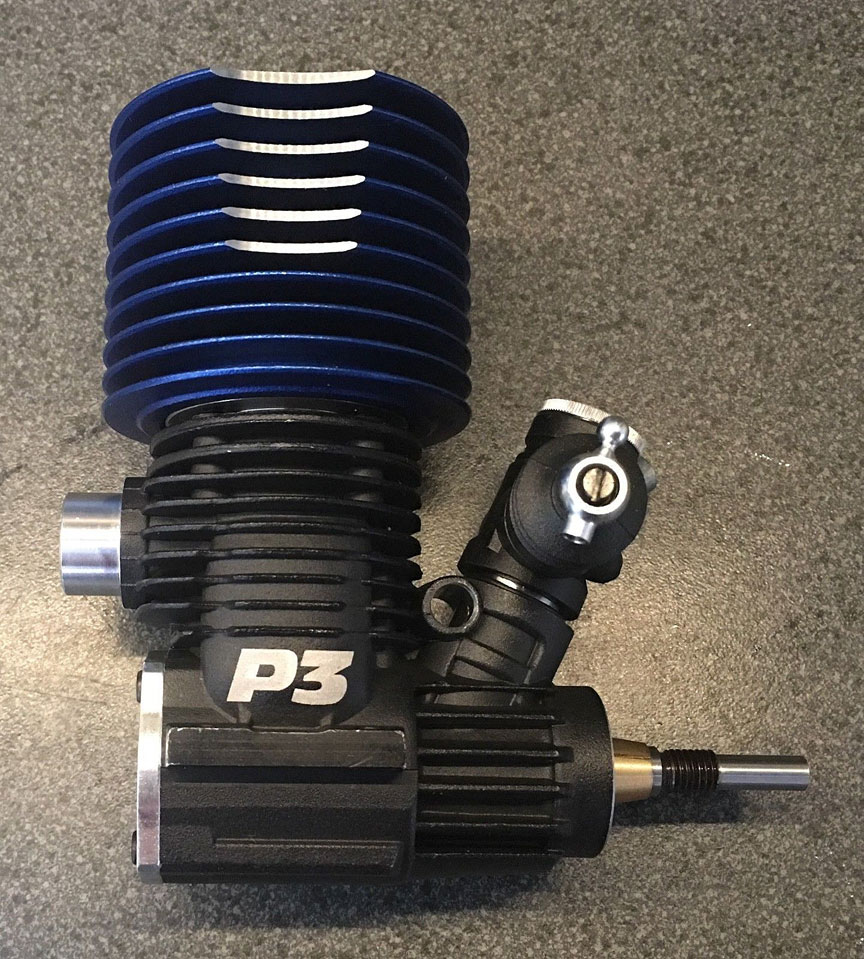A View from Broadway
Bee-Speed Comparison, Part 2
See Bee-Speed Comparison, Part 1
Models are fun!
By Ken Burdick
Yes Folks, it’s true.
When winter 2018-19 fell upon us in the frozen North (300 miles northeast of Seattle), building season got well under way.
The two B ships were built and are in the nonstop phase of finding pits and filling them with glazing compound.
The Buzzman (Buzz Wilson) said one time that there are only so many hours in a project before you go crazy. He was right. I thought I was saving time on one of the models by using a carbon fiber molded fuselage. No carving, no bandsaw, just glue the two halves together and away we go! Not the case. The seams were mismatched, I tacked it together with CA, then used epoxy and glass cloth on the inside. That alone created much filling and sanding, but the mold process left many pits of its own. The thing looked like a measles outbreak.
A .28 engine in the car world is just a .21 that has been punched out, so the engine would fit easily into a 21 Sport Speed pan that I had for a Rossi .21. The glass mold fuselage came from a 21 Sport Speed parts box and I had and luckily won a pile of aluminum wings at the speed champs last fall.
The model is smaller than its counterpart, the Pink Lady, and it has parts from a Lil Dynamite kit, once offered by Partner Products. At first glance, I thought it to be too small, but it works out to be just the right size.
The conventional construction of the Pink Lady seemed to be easier than the c-f model, but only because I had made all of the parts a year ago. The zit count on this model was considerably less even though it’s mostly covered in glass cloth.
So, the models are built, let’s get into the engines a bit.
Motor Madness

The SuperTigre X-29. All photos by Ken Burdick.
The exhaust timing was measured at 178 degrees of crank duration for the tuned pipe. This is about right so the pressure wave can do its thing and ram unburned fuel back into the engine. The rotor timing opens at 35 degrees after bottom dead center, and closes at 65 degrees after bottom dead center. I followed the Nick Sher article for the ST .29 as closely as I was able to. Mr. Sher holds the all-time record in B at 212 mph, back when we could use as much nitro as we could get to mix with oil, about 80 percent.
With larger flying lines of today and 10% nitro, something around 170-180 mph would make me pretty happy. Pipes can be finicky and much experimenting will be necessary for me to get it to run correctly. The idea is to get the pressure wave to shove the unburned fuel back into the engine before the piston closes. A bit like “whack-a-mole” at the speed of sound, which is why the pipe needs to heat up. There is a sonic component to all this bouncing around in there and it works at the right temperature
Go-go Gadget .28

The Go .28.
The ST .29 with a pipe is like a Formula 1 car, super-fast but needs everything working in concert.
Our go-go gadget .28 is very cool, but more like an NHRA dragster: cubes, good work and lots of air. If it was car, it would be doing wheelies off the line. “The New Math” speed team claims 180 out of a similar engine, I have only seen it do 160+ so far at contests, but it’s possible for sure.
The gadget has been “tweaked” a bit here and there, but is mostly stock. The head is currently set at whatever stock is to start with and will likely change. The spinner is from Dick Heart in Scotland. Anyone wanting a great spinner should contact him.
The needle valve was a problem and I had to modify an after-market ST .35 needle valve assembly to shoehorn it into the cowling.
I bent a piece of 3/32" brass tube at 90 degrees using a bender, cut off the fuel nipple and drilled it out for the brass tube, then soldered it to the body. The needle valve side stuck out too far to get in the cowling so I trimmed it to the correct length and use a small silicone fuel line to act as a tensioner for the needle valve instead of the brass lock nut. The assembly fits into the case but the hole was too big. Some lathe work produced a sleeve that is a press fit into the larger hole and just the right size for my spray bar. A slot was cut in the sleeve so fuel can flow into the engine.
The Go has much more conservative timing than the X-29 because it’s not running a full wave pipe. It uses a mini-pipe of about four inches from the face of the piston to the end of the .90 i.d. pipe. I used Luke Roy's pipe calculator to determine the interior diameter and length of the mini-pipe.
It is found under Grate Cajun calculators. The lil' pipe works by some sort of magic when high pressure gases from the exhaust are funneled down a tube of the right length and diameter, into low pressure (atmosphere). When they work properly, you can hear the RPM increase. There is no standing wave as in the full wave pipe, so it’s just efficient scavenging of the exhaust from the cylinder that makes it go.
Comparison between the two set ups us interesting.
X-29 on suction fuel system
Venturi size: .312
Head clearance: .006
Full wave pipe
RPM est: 28,000
Go. 28 on crankcase pressure
Venturi size: 584
Head clearance: stock
Mini pipe
RPM (mfg): 33,000
The Go instructions warn that “This may look like a toy engine, but it’s NOT a toy engine." Sure Bunkie, whatever you say.
I love the RPM specs -- 33k on what load? I guess they mean its usable torque curve. The X-29’s RPM is a guess at what it will need to be with the pipe kicked in on the prop I have selected for it.
That’s it for now, lil' geezers, let’s get through the winter and do some RPM comparison, shall we? Better still, get some flights recorded!
Picco-BOO!

The Picco .28.
Anybody that knows me also knows I really really like Picco engines. They are cool, great workmanship. Fast and not made in China.
I was just cursing eBay for no particular reason, when I spotted a new Picco .28 for like 1/3 of the original price. I know, I know, I said the gadget will be the one, and it will -- but guys, it’s a Picco! I sent the money via PayPal and they shipped it.
It didn’t show ... and didn’t show ... . The tracking said funny things like “isn at der shipperment," and so on for many weeks. I finally wrote to the shipper who is Dutch. They said I should go look for it and I reminded them I am the payee here. Then things got bad, and things got worse and it was rapidly approaching the point where I could not get a refund from eBay. I finally pushed and got the response “Take it easy!” Yah, I’ll show you easy ... .
I contacted eBay for a refund after they traced it going to San Francisco instead of Seattle. The refund arrived the next day, so no Picco. ... It’s now a week and a half since the refund and guess what just arrived in Seattle -- yup. Now to find out who to reimburse.
And now for the weather
December in Kamloops, it’s a balmy 5 degrees C, or for people like me, 41 degrees F. It’s nearly Christmas and it should be about -10c or 14 deg F. What, a blue and sunny sky -- I think I’ll go run engines.
I started with the fuel, 10% nitro with 20% oil, blended 50-50 synthetic and castor, the prop I chose was an APC 9x6 cut down to 7 x 6.
The x-29 is running suction and the Gadget is on a bladder. I chose the X-29 to go first.
About 5 turns open and it fired right off. My digital tach measured it at 20,100 RPM after a brief warmup.
Next came the Go .28. Somehow, I just knew it would be faster. Big hole, modern design, it just looked faster. The thing spit, sputtered and finally caught. The tubing tensioner for the needle valve split causing some difficulty in getting a steady run, but it sounded fast, the tach don’t lie -- here is how they stacked up.
X-29: 20,100 RPM
Go .28: 19,500 RPM
Pretty darn close, but winner and still champion is the X-29.
I will do some more measurements on the Go .28 to see if I can find the cause.
Getting a-head
After tearing down the Go-Go Gadget, I measured the head. It was a whopping .030 clearance. So much for stock. The head is now set at .006 and should be a good starting point. I expect to see some better RPM figures tomorrow if the weather holds out. Inspection of the rest of the engine showed great condition, no scratches in the piston surface or shiny spots that indicate rubbing in an out of round condition.
The key measurements are correct for this type of engine and are as I measure them below. In short, I only found the head lacking in ambition, the rest seems right in the wheelhouse.
|
|
Deck Height |
0.1360 |
Stroke / 2 |
0.3450 |
Rod/Stroke Ratio |
1.7870 |
Engine Displacement |
0.2841 |
Swept Volume from Exhaust Closing |
0.1873 |
Blow Down (DEG) |
18.42 |
Blow Down (Inches) |
0.0940 |
Exhaust Port Values |
|
Distance ATC |
0.4550 |
Distance BBC (Port HGT) |
0.2350 |
Port Duration (DEG) |
159.16 |
Piston ATC (DEG) |
100.42 |
Piston BBC (DEG) |
79.58 |
Transfer Port Values |
|
Distance ATC |
0.5490 |
Distance BBC (Port HGT) |
0.1410 |
Port Duration (DEG) |
122.33 |
Piston ATC (DEG) |
118.83 |
Piston BBC (DEG) |
61.17 |
Inlet (Crank Port or Rotor) Values |
|
Port Opens ABC (DEG Crank Port or Rotor) |
31.67 |
Port Opens BTC (DEG Crank Port or Rotor) |
148.33 |
Port Close ATC (DEG Crank Port or Rotor) |
61.63 |
Total Intake Timing (DEG Crank Port or Rotor) |
209.96 |
Winner by a nose!
 The Go-go engine was taking jumps, up and down RPM, and very little sustained long stretch runs. The head shims account for .017 of the stock clearances, and it makes sense that they have such a head clearance. Me? I want a good strong 30 seconds of all-out performance, so even with no head shims, it was still too much clearance.
The Go-go engine was taking jumps, up and down RPM, and very little sustained long stretch runs. The head shims account for .017 of the stock clearances, and it makes sense that they have such a head clearance. Me? I want a good strong 30 seconds of all-out performance, so even with no head shims, it was still too much clearance.
After some nighttime lathe work, the gadget head is now sitting .006 from the piston at TDC.
Weather today was not as nice as yesterday, but plenty good enough for a 2-ounce bag of fuel to be run through the gadget, and It looks as though the head did the trick, it tacked up at 20,130 or just a squeak faster than the X-29. Not bad for a $40.00 purchase on eBay. The X-29 still has the potential advantage because of the pipe, but the gadget is a cheap way to get into a reasonable competitive B speed project.
So stay tuned lil geezers, the air trials are next, at the Jim Walker Memorial in April.
And one more!

This is an OPS engine for B Speed once owned and set up by Glen Lee. I bought it from Bill Hughes. It's perfect in quality of rework.This one will be used during the season at some point.
-- Kennyb
Back to Bod Busters main page
Back to Speed main page
Flying Lines home page
This page was upated March 24, 2019

